- Recognizing and sustaining needs of an inter-generational personnel.
- Increase conscription and retention of folks from diverse background.
- Ensure organizational relationship with the society.
- Provide recruits with equal chances of progress at workplace.
- Augment recruitment and maintenance of people with disabilities.
- Avoid discrimination based on various grounds.
The duty of human resource department is to value diversities and ensure equality at work place. Cases of discrimination and prejudicial judgment have been reported frequently at work places hence the formation of standard laws and regulations to take care of such issues. The laws prohibit discrimination based on gender, sexual orientation, race, religion, marital status among others. Following these guideless, virtues like respect, equality and understanding among employees at workplace are assured. Accepting differences and variety at work place is the first step towards growth and development at any organization. In addition, it is necessary to understand that each person’s contribution at an organization is vital however small that contribution might be (Erling, 2011).
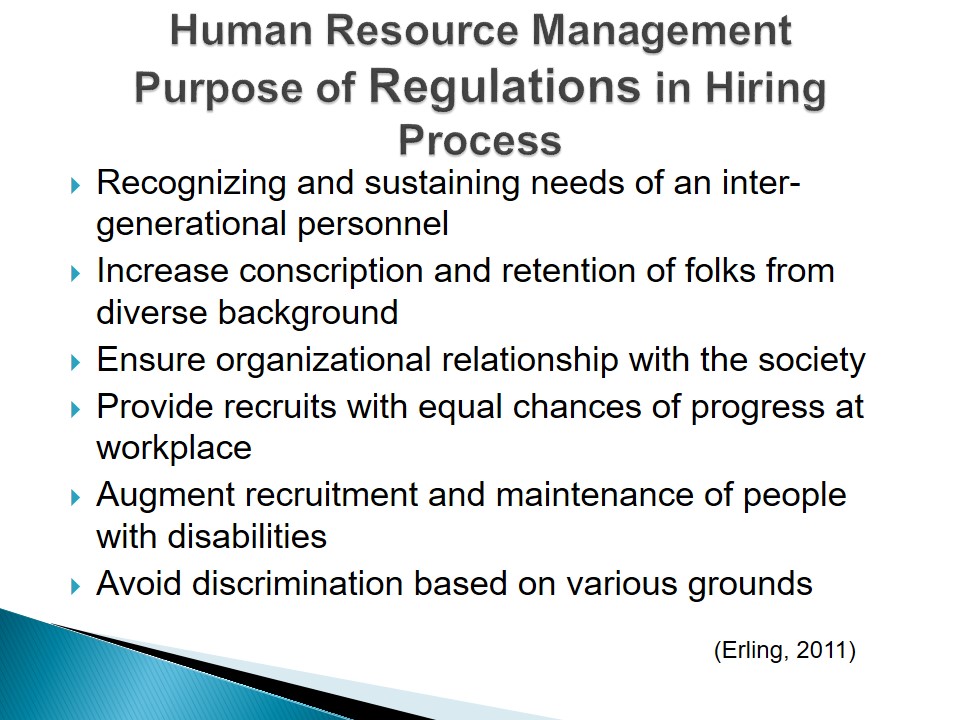
Designing Jobs
- Perform an outlined post analysis.
- Clearly categorize and describe tasks of a specific job.
- Spell out vital information on skills, tools and working environment.
- Have a well-written job account.
- Make your prospects lucid to employees.
- Define accurate descriptions of corporal requirements.
Designing jobs entail spelling out duties and responsibilities a certain of a certain position. Scholars have argued that it is necessary for human resource department to conduct an informed research on a particular position so as to ascertain what exactly the organization needs. Job description communicates to employees more than the managers can. A well spelt out job description is one-step towards success in an organization. Additionally, accurate description of physical requirements frees a firm from the blame of discrimination especially when dealing with people with disability (Brown, 2011).
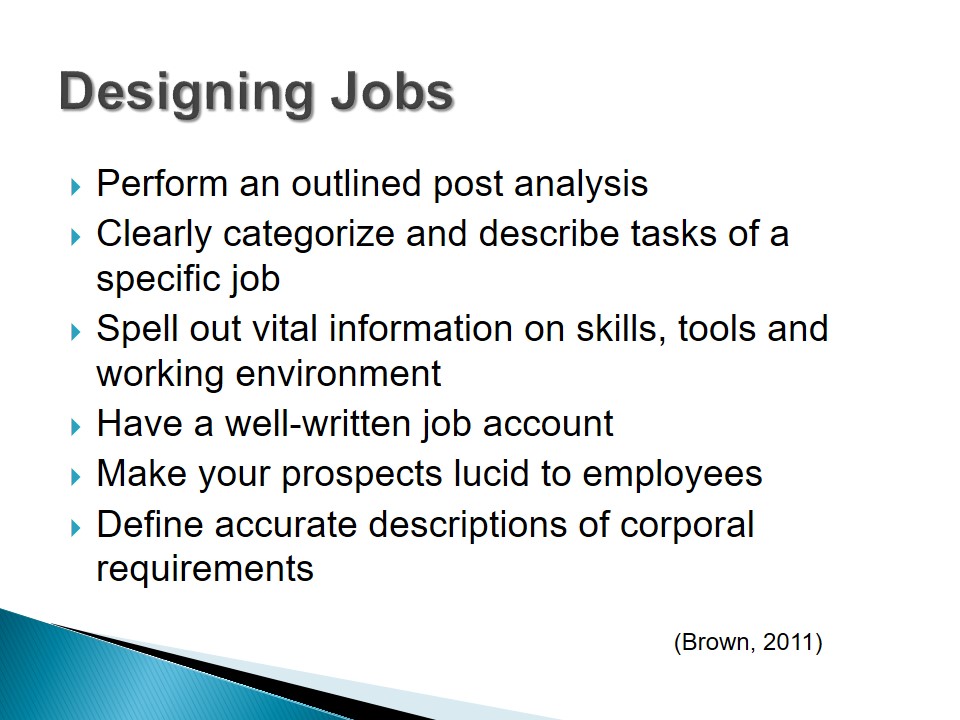
Effectual Job Description
- Allows room for enough flexibility.
- Measurable, timely and distinguishable.
- Provides reckonable focus for vigor and attention.
- Regularly restructured to contain new goals and chances of development.
- Acts as an essential part in hiring and recruitment.
- Effectively used to check day-to-day operations.
A job description is only effective if it is put in the right use. Well spelt out job descriptions help human resource managers to get the right people for a position during hiring process. Having the correct people for the right job is fundamental in an organization. Therefore, it is necessary for organizations to ensure that they have the right investment on the area of designing jobs (Swift & Booker, 2013).
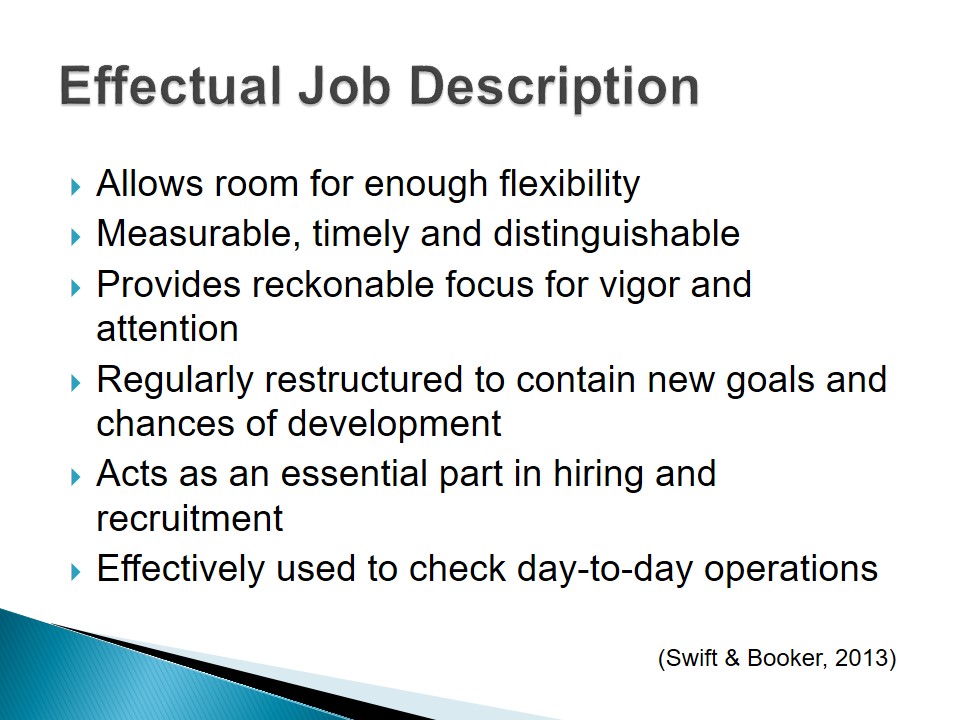
Recruitment process
- Identify the want or the area that needs reform.
- Identify any alteration anticipated for the position.
- Develop job stipulations and individual specifications.
- Announce the position extensively.
- Examine past conscription methods.
- Modify recruitment techniques to prevent segregation of applicants.
An ideal recruitment process involves discussion with the existing position holder. Discussion helps in identifying the need as well as prepares a good avenue for successful recruitment. Examining past recruitment methods is necessary to help in deciding which method is ideal for a particular need. In addition, examination of past methods helps cut down unnecessary spending and prevent discrimination in the recruitment process (Bryon, 2011).
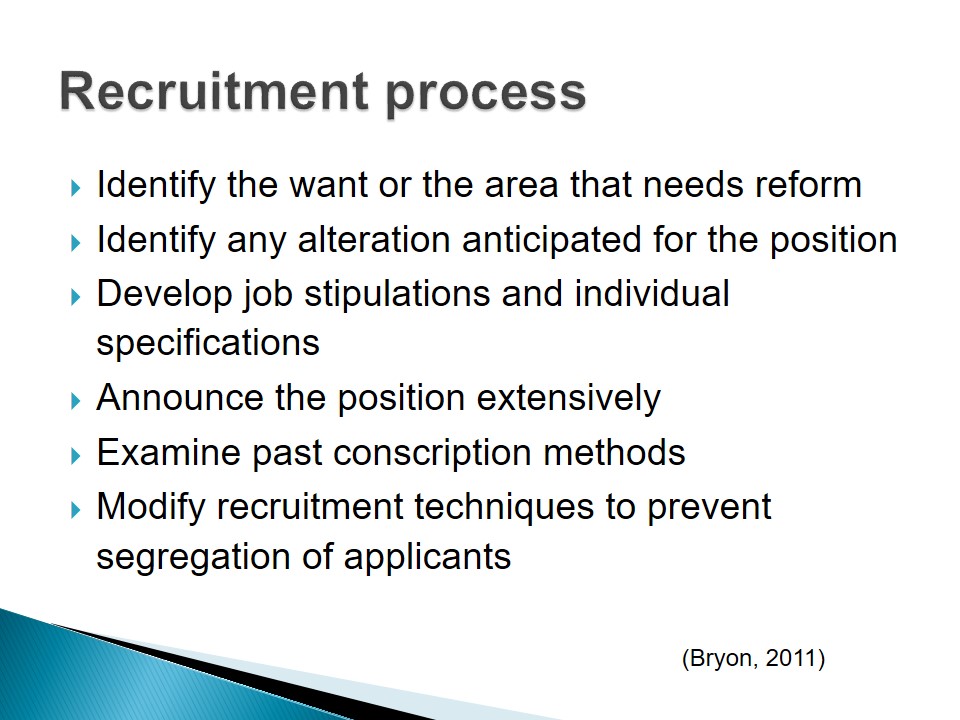
Selection process
- Use a standard form to shortlist candidates.
- Ensure equality during selection interview.
- Focus on proficiency, credentials and capacity to carry out the task.
- Selection principles should be formulated before applications are made.
- Have a prescribed marking scheme.
- Know applicant’s exceptional needs if any.
- Guarantee gender balance in the interview panel.
- Afford evidence for scores attained.
- Ensure consistency in using marking system.
- The interview panel should follow egalitarianism legislations.
- Ensure precision in the application outlines.
- Uphold the selection material for three years.
- Appraise the recruitment progression.
Selection is a very imperative aspect in recruitment. Any mistake done in this stage can have adverse effects on an organization. Issues of discrimination are often reported in this stage. Therefore, managers should ensure transparency in the selection process and the entire hiring process at large (Bryon, 2011).
The first step to conducting a transparent selection process is having the right team. The human resource manager should ensure balance in the interview board and make sure that the selected members of the board are conversant with equality legislations. The last stage of selection is to review the entire recruitment and selection process, and implement changes where necessary (Adler, 2007). Reviewing ensures that no mistakes are made in the selection process. At this stage, the interview panel gives reasons as to why they dismissed particular candidates and approved others. Such reports are presented to the higher management who then gives the final verdict of the selected recruit. In case two applicants whose qualifications match are selected, merits are used to pick the right candidates for the position.
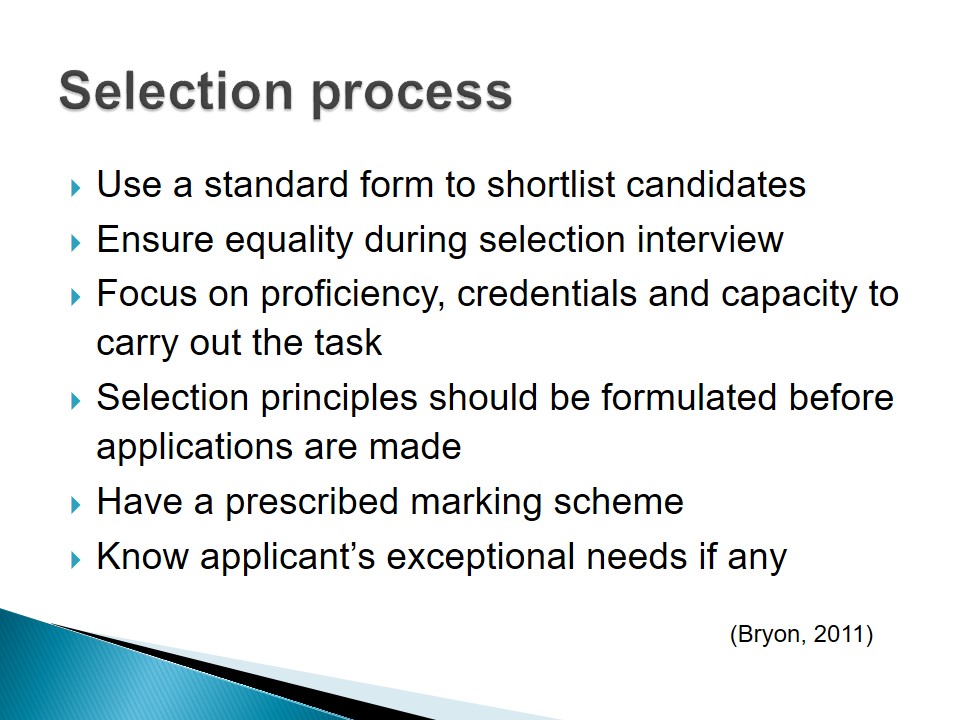
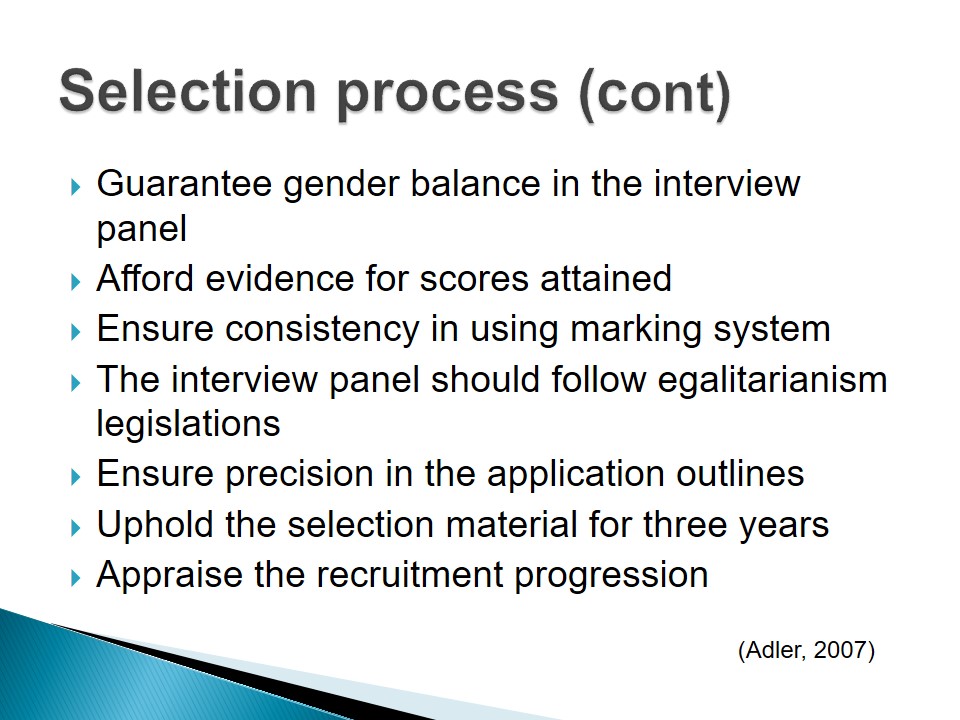
Orientation and Training Process
- Prepare fascinating tasks for worker’s first date.
- Enroll employees in new workers orientation class.
- Ensure employee’s work site is hygienic, presentable and in order.
- Have remuneration information parcel presented.
- Identify a team member to operate as a friend for the foremost week.
- Provide house pass for new staff.
- Review job description and executive charts.
- Introduce new employees to other workers.
- Find out employees general feeling.
- Discuss routine evaluation procedure with the employee.
- Decide on your training arrangement.
- Execute any necessary amendment.
Orientation programs are used to aid new employees get absorbed into the organization. Orientations assist new recruits in learning organizational culture, organizations expectations from its employees among other matters of importance. Consequently, employees judge the firm depending on how well the orientation program was conducted. Therefore, there is need for the management to ensure that they create the right image to new employees (Chan, 2011).
The best training program is worker initiated. Employees know the best solution to the issues affecting their stations; therefore, they are the best people to consult when planning for a training program. Consequently, managers should allow employees to give their views on training especially when dealing disabled people. A training program must be interesting if success is to be achieved (Chan, 2011). Interest in training involves trainers using varied techniques to avoid boredom and lose of information. Involvement of the trainee in the training and orientation program has been proved as one of the best ways of training. Involvement includes such aspects as discussion. In this aspect, both parties are given a chance to ask questions, which motivates trainees or new employees to be part of the program.
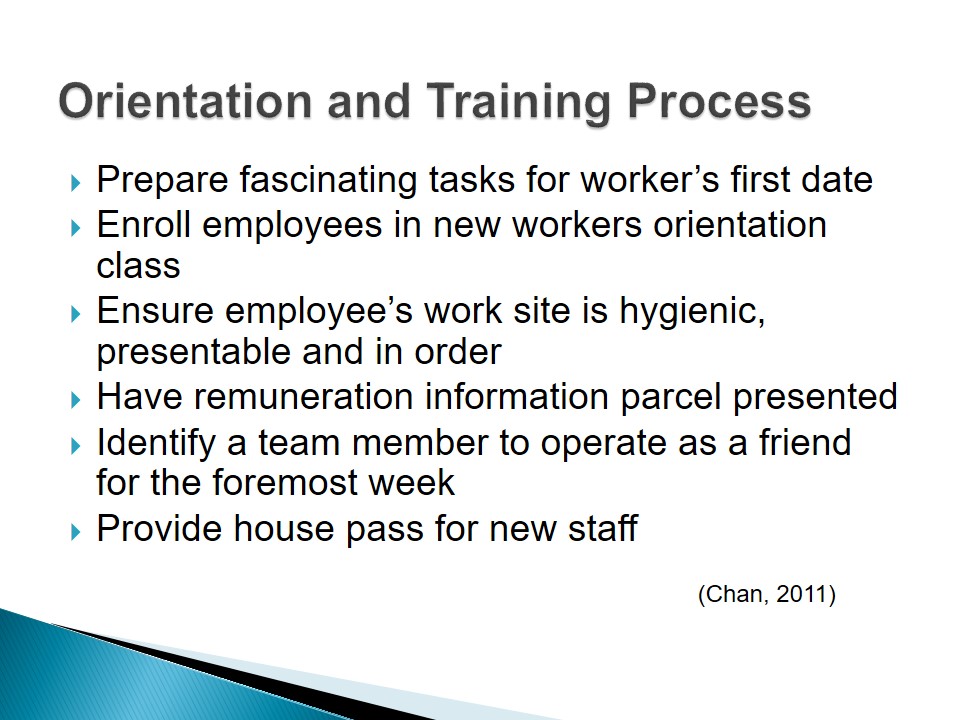

References
Adler, L. (2007). Hire with your head using performance-based hiring to build great teams. Hoboken, N.J: John Wiley & Sons.
Brown, J. (2011). The complete guide to recruitment a step-by-step approach to selecting, assessing and hiring the right people. Philadelphia, PA: Kogan Page.
Bryon, M. (2011). How to pass the UK’s national firefighter selection process : everything you need to know to succeed in the national assessments. London Philadelphia: Kogan Page.
Chan, W. (2011). Processes and process-orientation in foreign language teaching and learning. Boston: De Gruyter Mouton.
Erling, D. (2011). Match : a systematic, sane process for hiring the right person every time. Hoboken, NJ: Wiley.
Swift, K. & Booker, J. (2013). Manufacturing Process Selection Handbook From design to manufacture. Burlington: Elsevier Science.